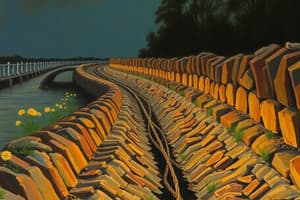Podcast
Questions and Answers
What listing is required for cables and insulated conductors installed in enclosures or raceways in underground installations?
What listing is required for cables and insulated conductors installed in enclosures or raceways in underground installations?
- For use in wet locations (correct)
- For use in hazardous locations
- For use in submerged locations
- For use in dry locations
What is the minimum cover requirement for direct-buried cable or conduit in underground installations?
What is the minimum cover requirement for direct-buried cable or conduit in underground installations?
- At least 450 mm above finished grade
- As specified in Table 3.0.1.5 (correct)
- At least 2,000 mm below finished grade
- At least 400 mm below finished grade
How should underground cable be installed under a building?
How should underground cable be installed under a building?
- In a raceway inside the building
- In direct contact with the building's foundation
- Without any additional protection
- In a raceway extended beyond the outside walls of the building (correct)
How should direct-buried conductors emerging from grade be protected?
How should direct-buried conductors emerging from grade be protected?
How should conductors entering a building be protected?
How should conductors entering a building be protected?
What is the requirement for direct-buried conductors and cables to be protected from damage?
What is the requirement for direct-buried conductors and cables to be protected from damage?
What is the required depth for burying underground service conductors that are not encased in concrete?
What is the required depth for burying underground service conductors that are not encased in concrete?
When subject to physical damage, what type of conduit should be used for installing conductors?
When subject to physical damage, what type of conduit should be used for installing conductors?
What kind of backfill should not be placed in an excavation to prevent damage to raceways and cables?
What kind of backfill should not be placed in an excavation to prevent damage to raceways and cables?
When are splices or taps allowed for direct-buried conductors or cables without the use of splice boxes?
When are splices or taps allowed for direct-buried conductors or cables without the use of splice boxes?
What should be provided to prevent physical damage to raceways or cables when backfill contains materials that may damage them?
What should be provided to prevent physical damage to raceways or cables when backfill contains materials that may damage them?
In what scenarios should conduits or raceways through which moisture may contact live parts be sealed or plugged?
In what scenarios should conduits or raceways through which moisture may contact live parts be sealed or plugged?
What type of conduit is suitable for installing conductors when the enclosure or raceway is subject to physical damage?
What type of conduit is suitable for installing conductors when the enclosure or raceway is subject to physical damage?
What should be used to identify the location of underground service conductors buried 450 mm or more below grade?
What should be used to identify the location of underground service conductors buried 450 mm or more below grade?
What materials should not be present in backfill to prevent damage to raceways, cables, or other substructures?
What materials should not be present in backfill to prevent damage to raceways, cables, or other substructures?
What should be used to prevent physical damage to raceways or cable when necessary due to backfill contents?
What should be used to prevent physical damage to raceways or cable when necessary due to backfill contents?
Flashcards are hidden until you start studying
Study Notes
Underground Installations
- Cables and insulated conductors in enclosures or raceways require a listing for underground installations.
- Direct-buried cables or conduits in underground installations require a minimum cover of 450 mm.
Installing Underground Cables
- Underground cables should be installed under a building through a raceway or conduit that is suitable for the location.
- Direct-buried conductors emerging from grade should be protected from physical damage.
Protecting Conductors and Cables
- Conductors entering a building should be protected from physical damage.
- Direct-buried conductors and cables should be protected from damage by using a conduit or raceway that is suitable for the location.
Installing Conductors and Raceways
- Underground service conductors that are not encased in concrete should be buried at a depth of at least 450 mm.
- When subject to physical damage, rigid metal conduit, intermediate metal conduit, or Schedule 40 PVC conduit should be used for installing conductors.
- Backfill containing rocks, stones, or debris that may damage raceways and cables should not be placed in an excavation.
Splices and Taps
- Splices or taps for direct-buried conductors or cables are allowed without the use of splice boxes when made in accordance with the manufacturer's instructions.
Preventing Damage
- When necessary due to backfill contents, physical damage to raceways or cables should be prevented using a conduit or raceway that is suitable for the location.
- Conduits or raceways through which moisture may contact live parts should be sealed or plugged.
Marking Underground Conductors
- Underground service conductors buried 450 mm or more below grade should be identified using a warning ribbon or a marker tape.
Backfill Materials
- Backfill materials that may damage raceways, cables, or other substructures, such as rocks, stones, or debris, should not be used.
- Physical damage to raceways or cables should be prevented using a conduit or raceway that is suitable for the location.
Studying That Suits You
Use AI to generate personalized quizzes and flashcards to suit your learning preferences.




